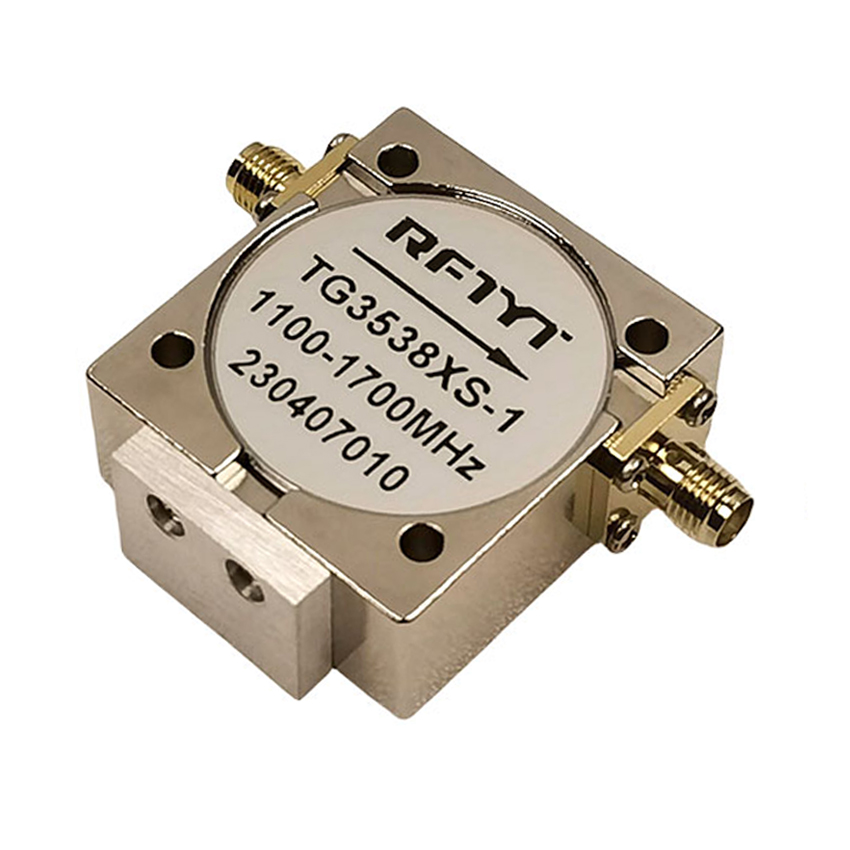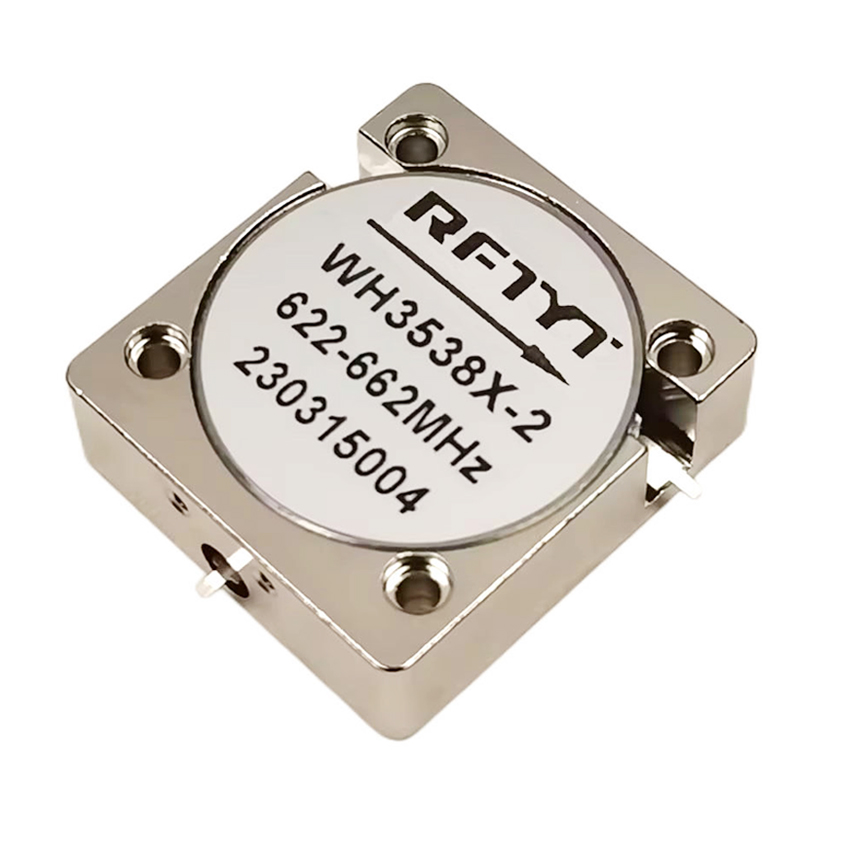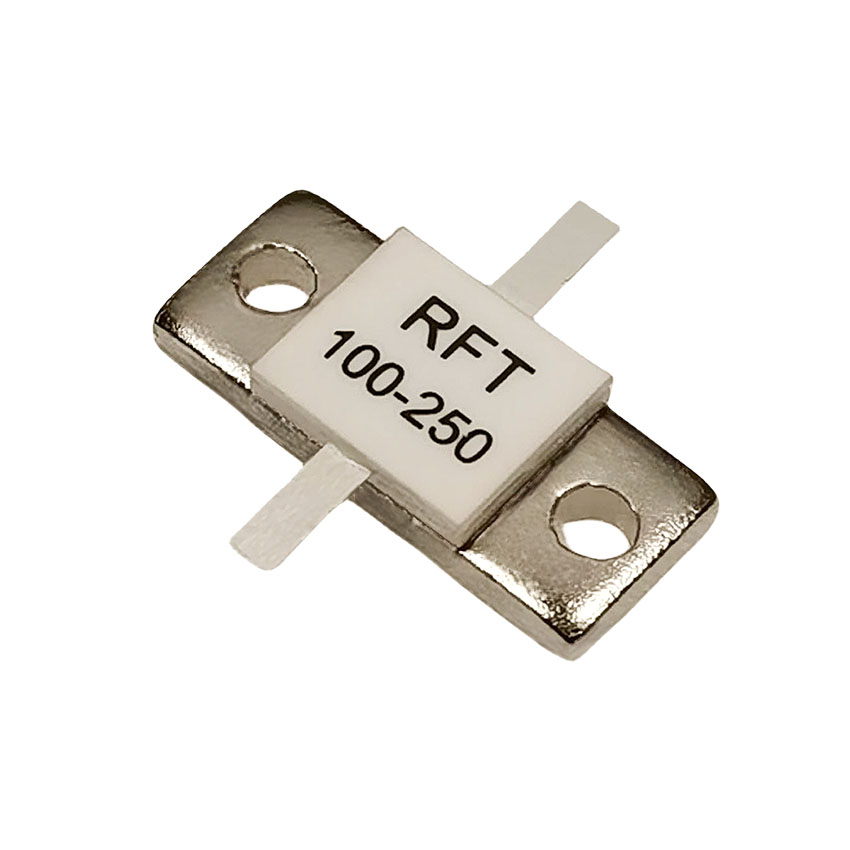
Products
Leaded Resistor
Leaded Resistor
Rated power: 10-400W;
Substrate materials: BeO, AlN
Nominal resistance value: 100 Ω (10-3000 Ω optional)
Resistance tolerance: ± 5%, ± 2%, ± 1%
Temperature coefficient: < 150ppm/℃
Working temperature: -55~+150 ℃
ROHS standard: Compliant with
Applicable standard: Q/RFTYTR001-2022
Lead length: L as specified in the specification sheet (can be customized according to customer requirements)

Data Sheet
| Power W |
Capacitance PF﹫100Ω |
Dimension(unit:mm) | Substrate Material | Configuration | Data Sheet(PDF) | |||||
| A | B | H | G | W | L | |||||
| 5 | / | 2.2 | 1.0 | 0.4 | 0.8 | 0.7 | 1.5 | BeO | A | RFTXX-05RJ1022 |
| 10 | 2.4 | 2.5 | 5.0 | 1.0 | 2.0 | 1.0 | 3.0 | AlN | A | RFTXXN-10RM2550 |
| 1.8 | 2.5 | 5.0 | 1.0 | 2.0 | 1.0 | 3.0 | BeO | A | RFTXX-10RM2550 | |
| / | 5.0 | 2.5 | 1.0 | 2.0 | 1.0 | 4.0 | BeO | B | RFTXX-10RM5025C | |
| 2.3 | 4.0 | 4.0 | 1.0 | 1.8 | 1.0 | 4.0 | AlN | A | RFTXXN-10RM0404 | |
| 1.2 | 4.0 | 4.0 | 1.0 | 1.8 | 1.0 | 4.0 | BeO | A | RFTXX-10RM0404 | |
| 20 | 2.4 | 2.5 | 5.0 | 1.0 | 2.0 | 1.0 | 3.0 | AlN | A | RFTXXN-20RM2550 |
| 1.8 | 2.5 | 5.0 | 1.0 | 2.0 | 1.0 | 3.0 | BeO | A | RFTXX-20RM2550 | |
| / | 5.0 | 2.5 | 1.0 | 2.0 | 1.0 | 4.0 | BeO | B | RFTXX-20RM5025C | |
| 2.3 | 4.0 | 4.0 | 1.0 | 1.8 | 1.0 | 4.0 | AlN | A | RFTXXN-20RM0404 | |
| 1.2 | 4.0 | 4.0 | 1.0 | 1.8 | 1.0 | 4.0 | BeO | A | RFTXX-20RM0404 | |
| 30 | 2.9 | 6.0 | 6.0 | 1.0 | 1.8 | 1.0 | 5.0 | AlN | A | RFTXXN-30RM0606 |
| 2.6 | 6.0 | 6.0 | 1.0 | 1.8 | 1.0 | 5.0 | BeO | A | RFTXX-30RM0606 | |
| 1.2 | 6.0 | 6.0 | 3.5 | 4.3 | 1.0 | 5.0 | BeO | A | RFTXX-30RM0606F | |
| 60 | 2.9 | 6.0 | 6.0 | 1.0 | 1.8 | 1.0 | 5.0 | AlN | A | RFTXXN-60RM0606 |
| 2.6 | 6.0 | 6.0 | 1.0 | 1.8 | 1.0 | 5.0 | BeO | A | RFTXX-60RM0606 | |
| 1.2 | 6.0 | 6.0 | 3.5 | 4.3 | 1.0 | 5.0 | BeO | A | RFTXX-60RM0606F | |
| / | 6.35 | 6.35 | 1.0 | 1.8 | 1.0 | 5.0 | AlN | A | RFTXXN-60RJ6363 | |
| / | 6.35 | 6.35 | 1.0 | 1.8 | 1.0 | 5.0 | BeO | A | RFTXX-60RM6363 | |
| 100 | 2.6 | 6.0 | 6.0 | 1.0 | 1.8 | 1.0 | 5.0 | BeO | A | RFTXX-60RM0606 |
| 2.5 | 8.9 | 5.7 | 1.0 | 1.5 | 1.0 | 5.0 | AlN | A | RFTXXN-100RJ8957 | |
| 2.1 | 8.9 | 5.7 | 1.5 | 2.0 | 1.0 | 5.0 | AlN | A | RFTXXN-100RJ8957B | |
| 3.2 | 9.0 | 6.0 | 1.0 | 1.8 | 1.0 | 5.0 | BeO | A | RFTXX-100RM0906 | |
| 5.6 | 10.0 | 10.0 | 1.0 | 1.8 | 2.5 | 5.0 | BeO | A | RFTXX-100RM1010 | |
| Power W |
Capacitance PF﹫100Ω |
Dimension(unit:mm) | Substrate Material | Configuration | Data Sheet(PDF) | |||||
| A | B | H | G | W | L | |||||
| 150 | 3.9 | 9.5 | 6.4 | 1.0 | 1.8 | 1.4 | 6.0 | BeO | A | RFTXX-150RM6395 |
| 5.6 | 10.0 | 10.0 | 1.0 | 1.8 | 2.5 | 6.0 | BeO | A | RFTXX-150RM1010 | |
| 200 | 5.6 | 10.0 | 10.0 | 1.0 | 1.8 | 2.5 | 6.0 | BeO | A | RFTXX-200RM1010 |
| 4.0 | 10.0 | 10.0 | 1.5 | 2.3 | 2.5 | 6.0 | BeO | A | RFTXX-200RM1010B | |
| 250 | 5.0 | 12.0 | 10.0 | 1.0 | 1.8 | 2.5 | 6.0 | BeO | A | RFTXX-250RM1210 |
| / | 8.0 | 7.0 | 1.5 | 2.0 | 1.4 | 5.0 | AlN | A | RFTXXN-250RJ0708 | |
| 2.0 | 12.7 | 12.7 | 6.0 | 6.8 | 2.5 | 6.0 | BeO | A | RFTXX-250RM1313K | |
| 300 | 5.0 | 12.0 | 10.0 | 1.0 | 1.8 | 2.5 | 6.0 | BeO | A | RFTXX-300RM1210 |
| 2.0 | 12.7 | 12.7 | 6.0 | 6.8 | 2.5 | 6.0 | BeO | A | RFTXX-300RM1313K | |
| 400 | 8.5 | 12.7 | 12.7 | 1.5 | 2.3 | 2.5 | 6.0 | BeO | A | RFTXX-400RM1313 |
| 2.0 | 12.7 | 12.7 | 6.0 | 6.8 | 2.5 | 6.0 | BeO | A | RFTXX-400RM1313K | |
Overview
This type of resistor does not come with additional flanges or heat dissipation fins, but is directly installed on the circuit board through welding, SMD or printed circuit board surface mount (SMD) methods. Due to the absence of flanges, the size is usually small, making it easy to install on compact circuit boards, enabling high integration circuit design.
Due to the structure without flange heat dissipation, this resistor is only suitable for low-power applications and is not suitable for high-power and heat dissipation circuits.
Our company can also customize resistors according to the specific requirements of customers.
The leaded resistor is one of the commonly used passive components in electronic circuits, which has the function of balancing circuits.
It adjusts the resistance value in the circuit to achieve a balanced state of current or voltage, thereby achieving stable operation of the circuit.
It plays an important role in electronic devices and communication systems.
In a circuit, when the resistance value is unbalanced, the current or voltage will be unevenly distributed, leading to the instability of the circuit.
The leaded resistor can balance the distribution of current or voltage by adjusting the resistance in the circuit.
The flange balancing resistor adjusts the resistance value in the circuit to evenly distribute current or voltage across various branches, thereby achieving balanced operation of the circuit.
The leaded resistor can be widely used in balanced amplifiers, balanced bridges, and communication systems
The resistance value of the leaded should be selected based on specific circuit requirements and signal characteristics.
In general, the resistance value should match the characteristic resistance value of the circuit to ensure the balance and stable operation of the circuit.
The power of the leaded resistor should be selected according to the power requirements of the circuit. In general, the power of the resistor should be greater than the maximum power of the circuit to ensure its normal operation.
The leaded resistor is assembled by welding the flange and double lead resistor.
The flange is designed for installation in circuits and can also provide better heat dissipation for resistors during use.
Our company can also customize flanges and resistors according to specific customer requirements.











